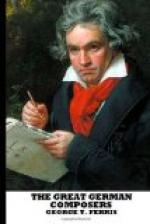Two years after “The Creation” appeared “The Seasons,” founded on Thomson’s poem, also a great work, and one of his last; for the grand old man was beginning to think of rest, and he only composed two or three quartets after this. He was now seventy years old, and went but little from his own home. His chief pleasure was to sit in his shady garden, and see his friends, who loved to solace the musical patriarch with cheerful talk and music. Haydn often fell into deep melancholy, and he tells us that God revived him; for no more sweet, devout nature ever lived. His art was ever a religion. A touching incident of his old age occurred at a grand performance of “The Creation” in 1808. Haydn was present, but he was so old and feeble that he had to be wheeled in a chair into the theatre, where a princess of the house of Ester-hazy took her seat by his side. This was the last time that Haydn appeared in public, and a very impressive sight it must have been to see the aged father of music listening to “The Creation” of his younger days, but too old to take any active share in the performance. The presence of the old man roused intense enthusiasm among the audience, which could no longer be suppressed as the chorus and orchestra burst in full power upon the superb passage, “And there was light.”
Amid the tumult of the enraptured audience the old composer was seen striving to raise himself. Once on his feet, he mustered up all his strength, and, in reply to the applause of the audience, he cried out as loud as he was able: “No, no! not from me, but,” pointing to heaven, “from thence—from heaven above—comes all!” saying which, he fell back in his chair, faint and exhausted, and had to be carried out of the room.
One year after this Vienna was bombarded by the French, and a shot fell in Haydn’s garden. He requested to be led to his piano, and played the “Hymn to the Emperor” three times over with passionate eloquence and pathos. This was his last performance. He died five days afterward, aged seventy-seven, and lies buried in the cemetery of Gumpfenzdorf, in his own beloved Vienna.
VI.
The serene, genial face of Haydn, as seen in his portraits, measures accurately the character of his music. In both we see health fulness, good-humor, vivacity, devotional feeling, and warm affections; a mind contented, but yet attaching high importance to only one thing in life, the composing of music. Haydn pursued this with a calm, insatiable industry, without haste, without rest. His works number eight hundred, comprising cantatas, symphonies, oratorios, masses, concertos, trios, sonatas, quartets, minuets, etc., and also twenty-two operas, eight German and fourteen Italian.




